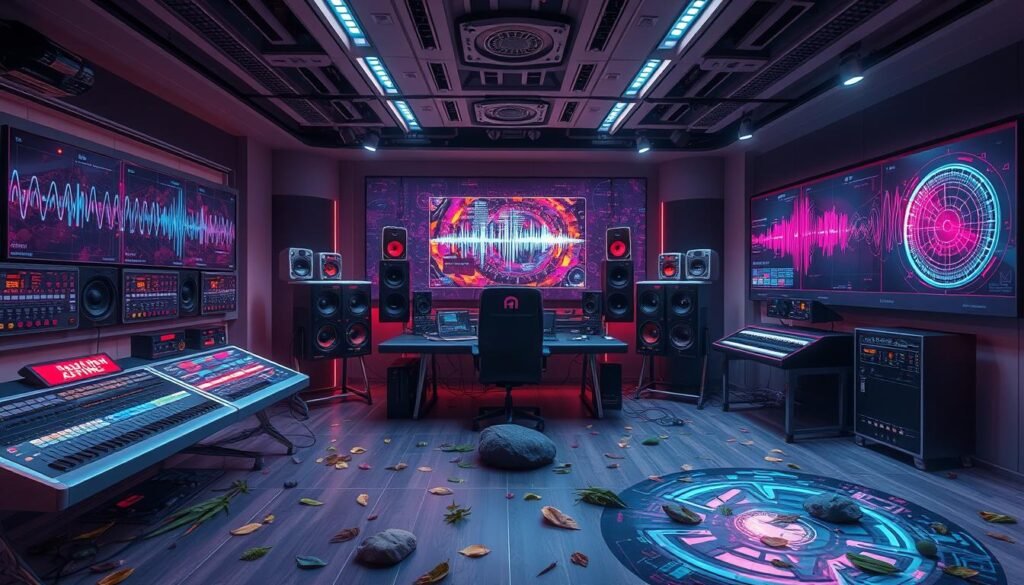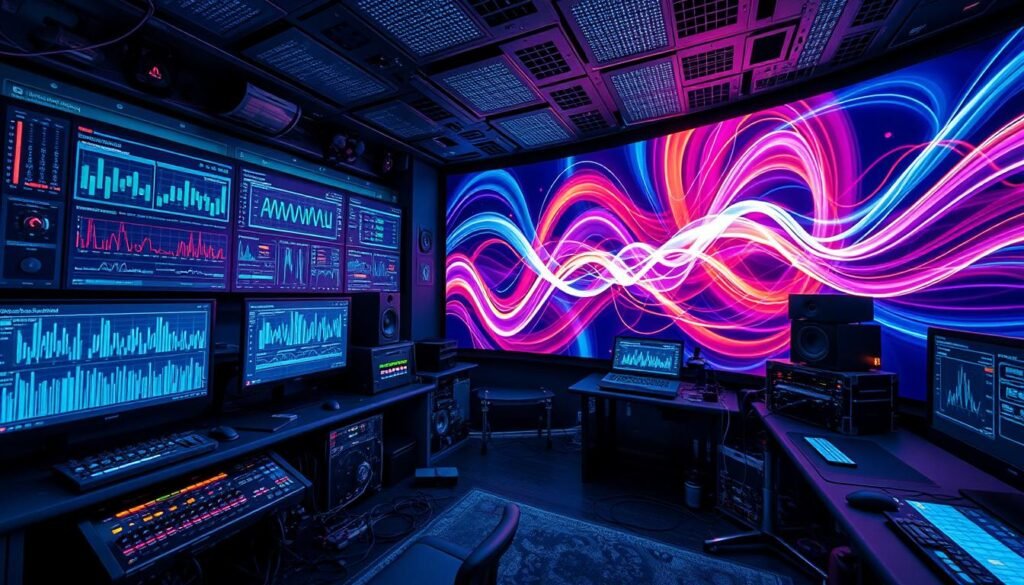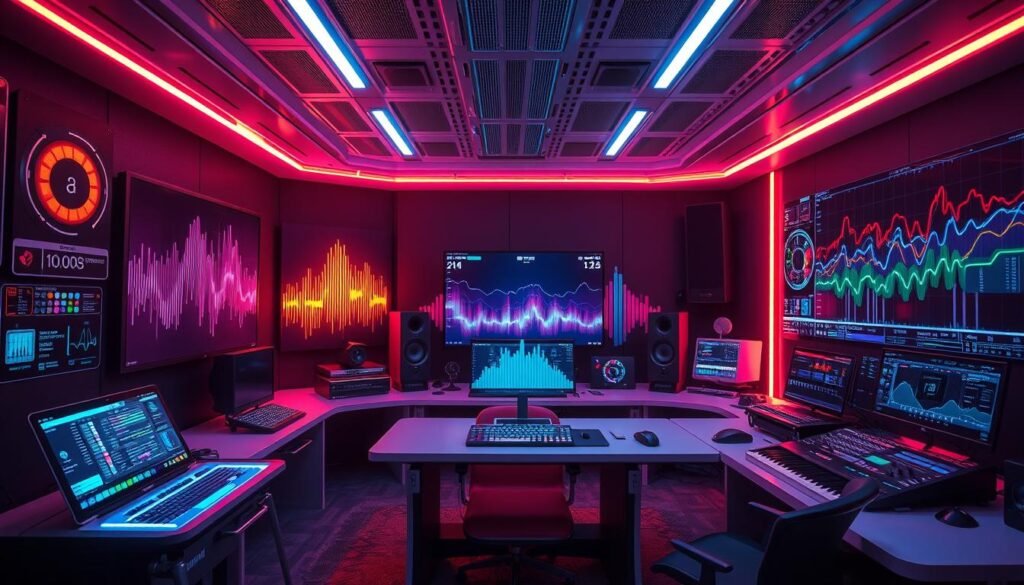Did you know AI can make sound effects way faster than old methods? In fast-paced fields like gaming and filmmaking, this speed is key. Now, you can use AI sound design to make realistic sound effects quickly and well.
The way we make sound has changed a lot with AI. Tools like ElevenLabs and Genny let you make sounds just right for your project. This means your audio fits perfectly with what you see on screen. These tools help everyone, from newbies to pros, make great audio fast.
AI is changing how we make audio, especially for immersive experiences. Whether you're making a game or a movie, AI sound tools can help. They make it easy to bring your ideas to life. For more on how these tools handle your data, check out privacy policies.
Key Takeaways
- AI sound design makes audio production faster.
- Customization options let you tailor sound effects for your project.
- AI tools spark creativity, letting you explore audio ideas quickly.
- The gaming and film industries are using AI sound effects a lot.
- Easy-to-use platforms help both new and experienced users make top-notch audio.
Introduction to AI Sound Design
AI sound design is changing how we make and use audio in different ways. It uses artificial intelligence in audio to improve creative work in music and production. Machine learning helps by looking at lots of audio data, making it easy to create custom sound effects fast.
Gaming, film, and advertising are seeing big improvements thanks to AI sound design. For example, AI sound effect generators can make creativity jump by 90%. This lets teams try out new sounds. These tools also save time and cut production costs by 40% by doing tasks that sound designers used to do.
The sound quality is also top-notch, with AI effects improving by 85% in sound quality. In gaming, about 80% of developers use AI sound generators for quick sound tests and adding sounds. This shows how important AI is for making games feel real.
In film and animation, about 70% of professionals use AI generators to make unique sounds. Social media creators also benefit, with about 65% using AI to improve their video sounds on YouTube and TikTok.
As machine learning and neural networks get better, AI sound design will keep getting better. Tools like ElevenLabs and Synthesia are leading the way in realistic and customizable audio. You can learn more about these tools and their uses by visiting this helpful resource.
Using AI sound design can make your work easier and open up new creative paths. The growth of AI in audio is key for many fields, including e-learning, voice assistants, entertainment, and gaming. It's a smart choice for anyone working with sound.
What Are Realistic Sound Effects?
Realistic sound effects are key to making audio experiences better, especially in virtual reality and movies. They mimic real-life sounds, making things feel more real and engaging. Things like pitch, volume, and texture help make these sounds feel authentic.
Adding realistic sound effects can make a big difference in a project. For example, in games, AI can create a wide range of sounds. This makes the game world feel more alive, keeping players hooked.
Realistic sound effects also change based on what's happening. Game makers can tweak sounds using AI during playtests. This lets them improve or change sounds, making sure the audio fits the game's mood. It makes sound design easier and cheaper than using lots of field recordings or buying big sound libraries.
| Attributes of Realistic Sound Effects | Importance |
|---|---|
| Authenticity | Enhances immersion and engagement |
| Diversity | Provides rich backgrounds and context-specific actions |
| Adaptability | Allows quick adjustments based on feedback |
| Cost-Effectiveness | Reduces the need for expensive sound libraries |
In short, realistic sound effects are vital for creating engaging audio that connects with listeners. Thanks to AI, sound designers can now easily make their projects sound more real, taking them to new levels.
How to Generate Realistic Sound Effects Using AI
AI has changed the game in sound design. Now, you can make realistic sound effects with just a few clicks. Text-to-sound technology lets you enter text and get amazing sound effects. This makes creating sounds easier and opens up new possibilities.
The Role of Text-to-Sound Technology
Text-to-sound tech lets you describe sounds in detail. For example, ElevenLabs Sound Effects AI turns your text into top-notch audio. This is great for films, games, or any creative project. AI makes sure the sounds match what you want, improving your work.
Describing Sounds for Effective AI Generation
Clear language is key for AI to make great sounds. For example, saying “a soft whoosh through the trees” helps AI create the right sound. Tools like Krotos Studio with AI presets make it even better. You can tweak sounds with an X-Y pad, creating detailed soundscapes.
| Technology | Description |
|---|---|
| ElevenLabs Sound Effects AI | Transforms text descriptions into realistic sound effects, ideal for various projects. |
| Krotos Studio | Utilizes AI-powered presets for nuanced sound generation with an interactive X-Y pad. |
| PopPop AI | A free tool that generates diverse sound effects, catering to casual and professional users. |
| ClipMove | Offers a simple, three-step process to quickly generate realistic sound effects. |
| MyEdit | Combines sound generation with editing features, allowing for customization and export. |
| TopMediai | An upcoming platform with a user-friendly interface for customizable sound effects. |
AI-Powered Foley: A New Era of Sound Creation
Foley art is key in film, TV, and games, adding depth and realism. It involves making everyday sounds to improve the audio experience. AI-powered foley is changing sound creation fast. New tools make sound effects quicker and better, changing how sound designers work.
Understanding Foley Art and Its Importance
Foley art is about making sounds that tell stories. Sounds like footsteps, clothes rustling, or dishes clinking are crucial. Foley artists create these sounds, adding depth that draws viewers in. AI now makes these sounds fast and well, making production quicker without losing quality.
How AI Enhances Foley Techniques
AI tools make creating sound effects easier. One tool can make sounds from text in just 10 seconds. It changes the old way of doing things.
Features like “prompt_influence” make sounds fit the story better. ElevenLabs shows how this tech makes top-notch sound design accessible. It's changing media production, making quality effects affordable for all.
Exploring Audio Synthesis Techniques
Audio synthesis has changed how we make and change sounds in the digital world. It lets you create amazing sounds. Knowing the different types of audio synthesis is key to understanding how neural audio synthesis makes realistic sounds.
Types of Audio Synthesis Used in AI
There are many types of audio synthesis used in AI sound making. Each type has its own purpose and special abilities:
- Subtractive Synthesis: This method starts with a full sound. By removing certain frequencies, you can change the sound as you want.
- Additive Synthesis: This method combines simple sounds to make complex ones. It lets you control the sound's details.
- Wavetable Synthesis: This uses recorded waveforms to make sounds. It's great for making a wide range of sounds, especially in electronic music.
The Benefits of Using Neural Audio Synthesis
Neural audio synthesis is a game-changer for sound making. It uses machine learning to create sounds. Its main benefits are:
- Complex Sound Replication: It can copy detailed sound environments very well.
- Flexibility in Composition: Changing settings is easy, which helps in creating music.
- High-Quality Output: It makes sounds clearer, making music better to listen to.
Tools like Google's MusicLM have made music creation better. They can turn text into music. WaveGAN can even make sounds from scratch. This shows how powerful audio synthesis is in AI.
| Type of Synthesis | Description | Benefits |
|---|---|---|
| Subtractive Synthesis | Filters out frequencies from a sound source. | Intuitive shaping of tones. |
| Additive Synthesis | Combines simple waveforms to build sound. | Detailed harmonic control. |
| Wavetable Synthesis | Uses pre-recorded waveforms to create sounds. | Broad sound palette for complex compositions. |
Machine Learning in Audio Generation
Machine learning has changed many fields, including AI sound design. It lets algorithms understand and predict audio features. This leads to machine learning audio generation, making sound effects more realistic.
Autoregressive models, like WaveNet from DeepMind, are big wins. They create sounds that seem real, showing how far machine learning can go.
Since 2013, variational autoencoders (VAEs) have been key in sound making. These neural networks make different sounds, helping create unique audio.
Generative Adversarial Networks (GANs), introduced in 2014, work by spotting fake and real sounds. They're great at making new content, like music and sounds, pushing AI sound design forward.
The transformer architecture, made for text, now helps with sound and music. It uses attention to better predict and connect audio elements, leading to better sounds.
AudioCraft shows the latest in machine learning audio generation. It has three models: MusicGen, AudioGen, and EnCodec. MusicGen makes music from text, trained on Meta music. AudioGen creates audio from text, using public sounds.
The EnCodec decoder makes music better with less noise. AudioCraft lets users design and test models, opening up new creative paths. This open-source tool is changing how we make audio and music.
| Model | Functionality | Training Source |
|---|---|---|
| MusicGen | Generates music from text prompts | Meta-owned licensed music |
| AudioGen | Generates audio from text prompts | Public sound effects |
| EnCodec | High-quality music generation | N/A |
The power of machine learning audio generation to change the audio world is clear. With tools like AudioCraft, you can explore new creative spaces and make top-notch audio for your projects. The future of sound design is exciting and more open than ever.
Creating Realistic AI Soundscapes
The rise of realistic AI soundscapes changes how sound is used in media. It's key to know what makes a soundscape immersive. This part will cover those elements and show off AI soundscapes.
Elements of an Immersive Soundscape
To make a soundscape engaging, you need a few key things:
- Layering: Mixing different audio tracks for depth and richness.
- Spatialization: Placing sounds in space to give direction and distance.
- Use of Ambient Sounds: Adding background noises to set the mood and scene.
When you mix these elements well, you create audio that grabs listeners and pulls them into the story.
Examples of AI-Generated Soundscapes
Here are some examples of AI soundscapes that show how they improve audio:
- AIVA: It makes special audio clips for themes and moods, changing movie and game soundtracks.
- Soundly: It uses AI to find and suggest sound effects fast, making it easier to create.
- Boom Library: It's famous for top-notch sound effects and uses AI to let designers tweak and make new sounds.
- Adobe Audition: It has AI tools for making sounds, reducing noise, and improving audio, helping pros.
AI soundscapes make games and movies more immersive and personal. With these tools, you can make soundscapes that change with the story or game, changing how we enjoy media.
Data-Driven Sound Design: The Future of Audio
Data-driven sound design is leading the way in audio innovation. It's all about using data to make sound that really connects with people. This approach makes audio experiences more engaging and focused on the audience.
How Data Improves Sound Generation
Data is key in today's digital world for sound generation. By understanding what people like, sound designers can create audio that hits the mark. For example, AI can analyze listening habits to make music that fits certain tastes.
This use of data boosts creativity and makes audio more likely to be a hit. It's a win-win for both the creators and the listeners.
Integrating Data into Your Sound Projects
To use data well in your sound projects, follow these steps:
- Use analytics tools to get feedback from your audience.
- Look at music and audio trends in your target market.
- Use user data to guide your sound design choices.
- Test and tweak your audio based on data from different platforms.
By doing these things, you can really improve your audio work. It's all about listening to what your audience wants. The audio AI market is expected to hit $12 billion by 2030, showing how crucial data-driven sound design is.
| Feature | Benefit | Impact on Sound Generation |
|---|---|---|
| Data Analytics | Identifies user preferences | Enhances audio personalization |
| Real-Time Feedback | Improves creative processes | Boosts engagement and reception |
| AI Algorithms | Automates sound design tasks | Increases efficiency and quality |
Steps to Get Started with AI Sound Effect Creation
Exploring AI sound effect creation can really boost your audio projects. Whether you're making videos or creating audio experiences, the right tools and setup are key. They can make your work stand out a lot.
Choosing the Right Tools for Sound Generation
Choosing the right tools is essential for AI sound effect creation. There are many software and online platforms for different sound design needs. Some top picks include:
- PopPop AI: This online generator lets you make sound effects with just text prompts. You can preview up to two sounds at once.
- ElevenLabs: It's great for creating voices that sound real, perfect for voiceovers.
- Logic Pro X: This software combines AI with traditional sound design tools. It gives you a lot of creative freedom.
These tools make creating sounds faster and better. They can really improve your project.
Setting Up Your Audio Projects
Setting up your audio projects right can save time and boost creativity. Here's a simple guide to help you:
- Create a clear project folder: Keep all your audio files, assets, and notes in one place. It makes things easier to find.
- Define your sound palette: Pick the effects and sounds you want for your project. Make sure they match the mood you're aiming for.
- Use markers: Mark important moments in your audio timeline. It helps you place sound effects correctly with visuals.
- Test and review: Listen to your project to check if the sound effects work well. Adjust them if needed for the best effect.
By following these steps and using AI, you can explore all the creative possibilities in audio design.
Conclusion
The world of AI sound design is changing fast, marking a big shift in audio creative fields. AI tools are now available, offering new ways to work on music and sound effects. With advanced tech like neural networks, you can make audio that's just right for your needs.
Platforms like SoundMind and AIVA show what the future of audio looks like. They let you tweak sounds in ways you never could before. With huge databases, you can pick from thousands of sounds and music, making your projects perfect.
Exploring AI sound design can take your audio projects to the next level. Using AI tools puts you at the edge of digital creativity. Check out this resource for more on AI sound effects and their impact in different fields.







